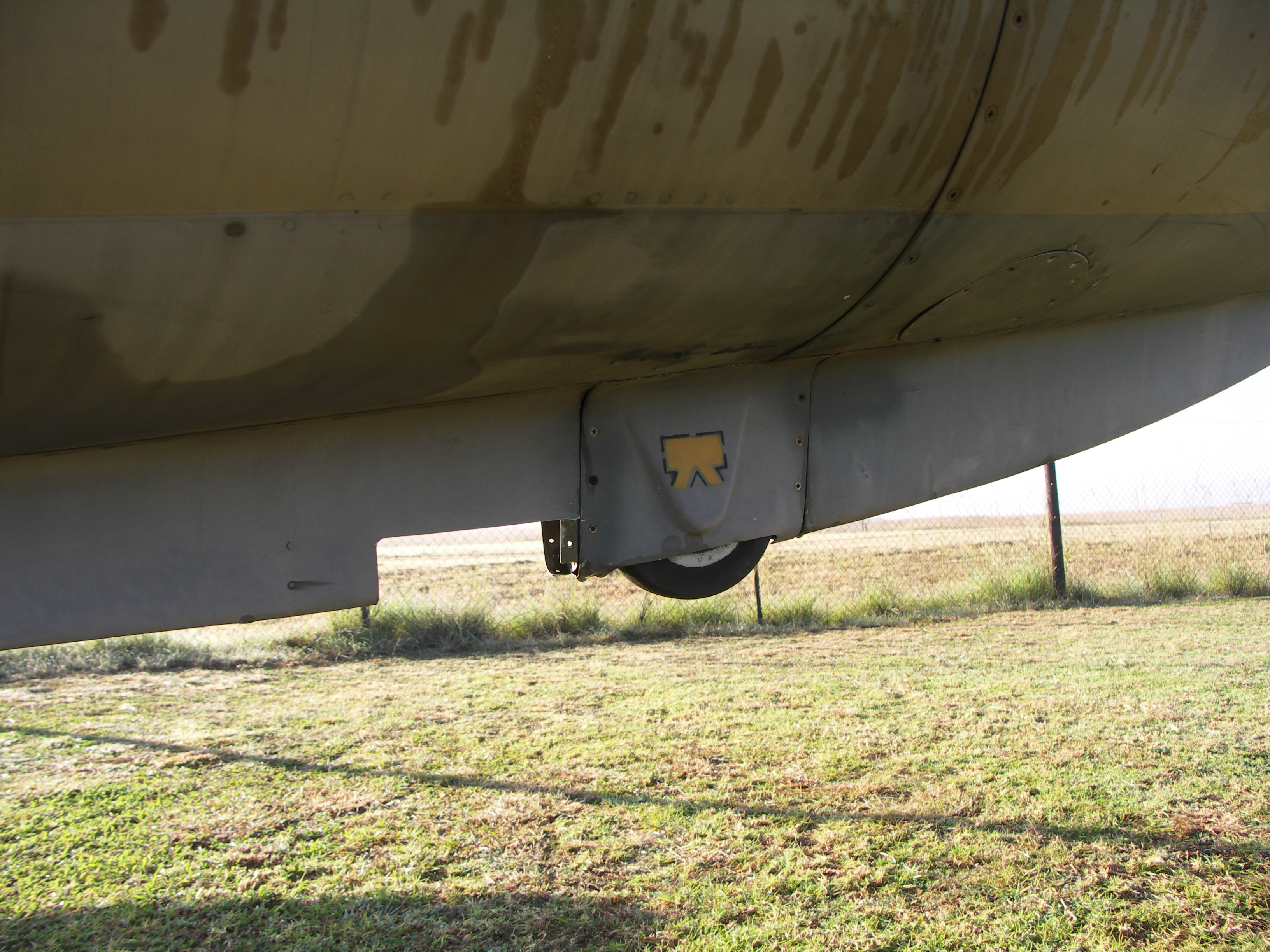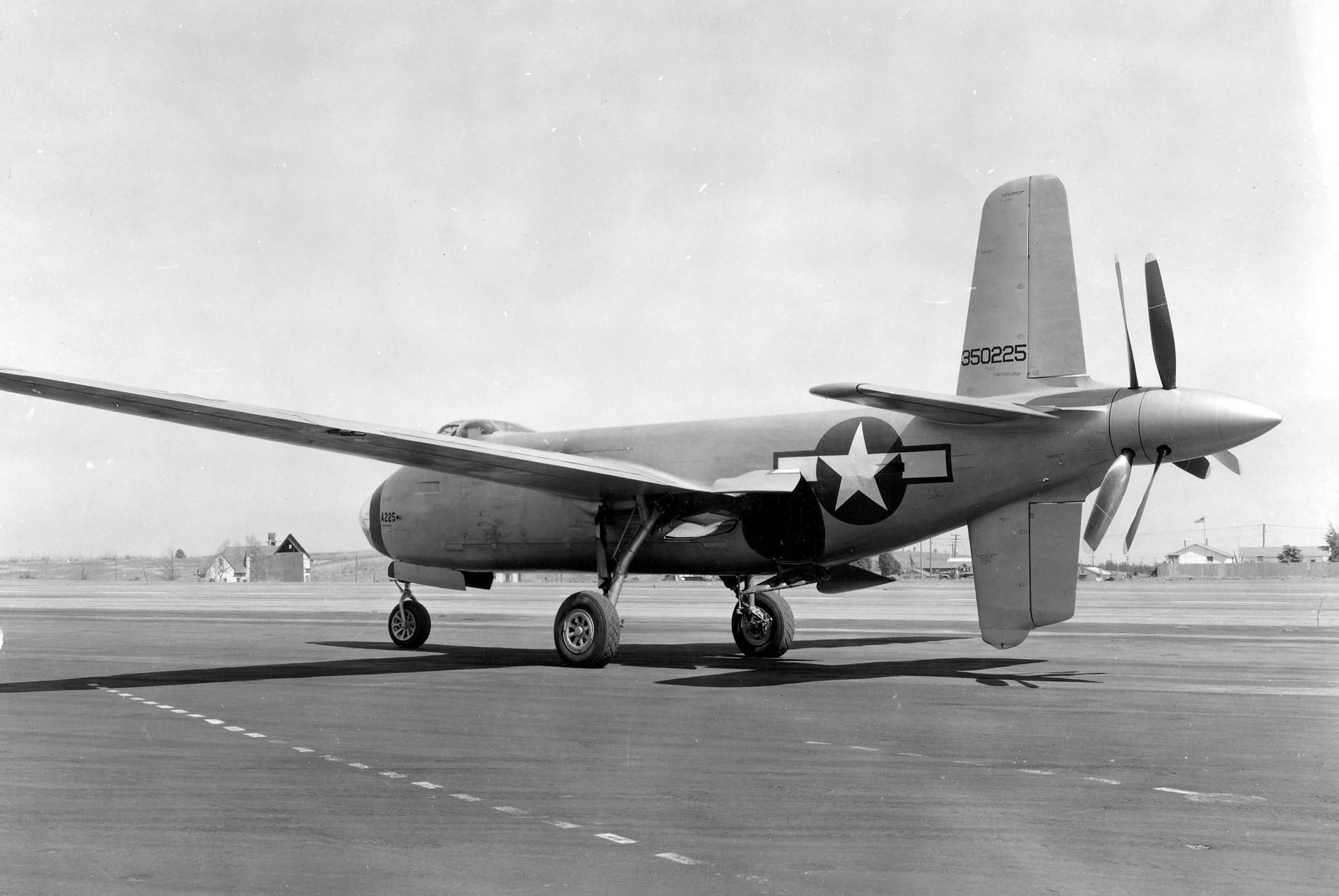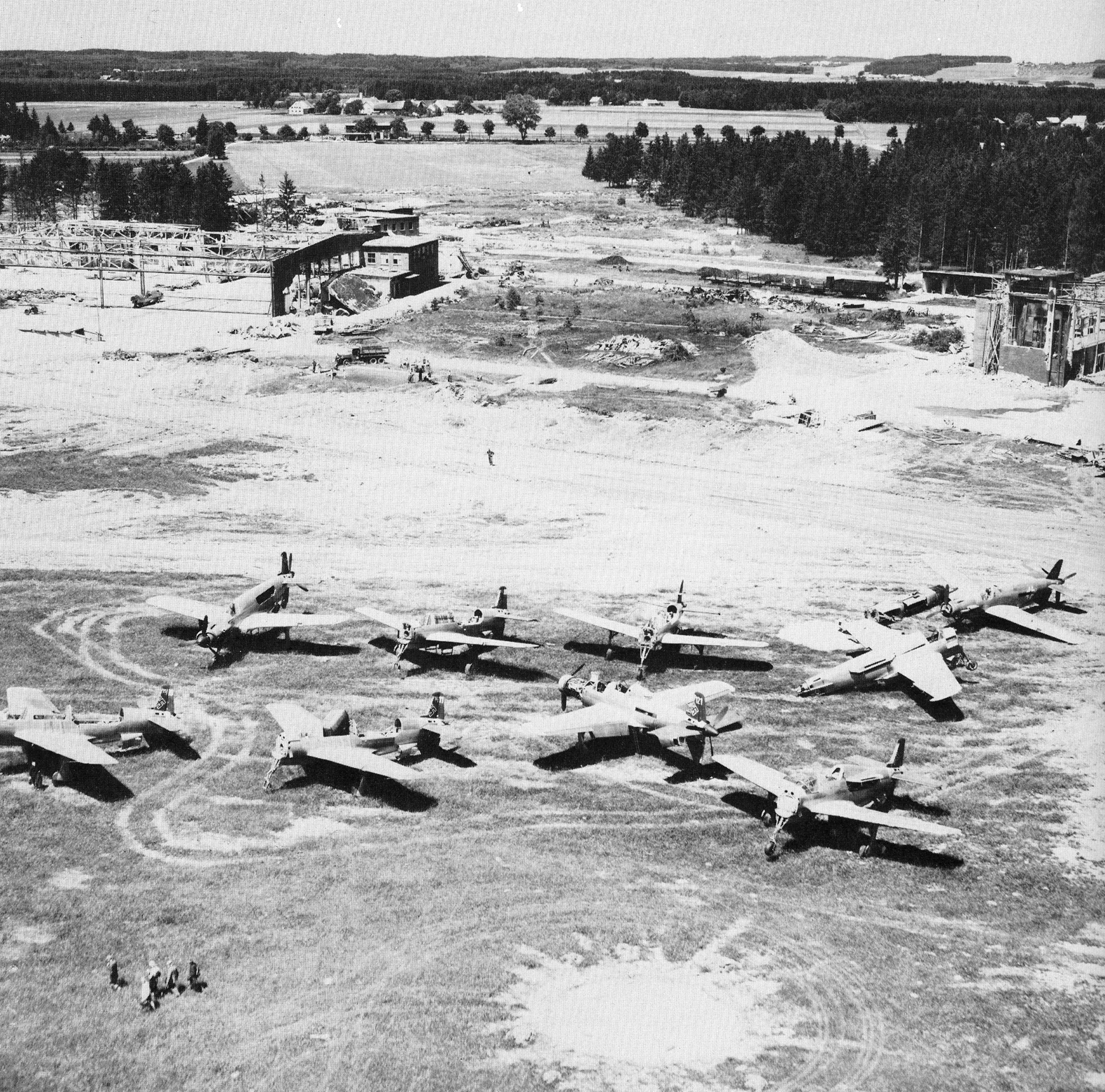|
Göppingen Gö 9
The Göppingen Gö 9 was a German research aircraft built to investigate the practicalities of powering a plane using a pusher propeller located far from the engine and turned by a long driveshaft. Design and development In 1937, Claudius Dornier observed that adding extra engines and propellers to an aircraft in an attempt to increase speed would also attract a penalty of greater drag, especially when placing two or more engines within nacelles mounted on the wings. He reasoned that this penalty could be minimized by mounting a second propeller at the rear of an aircraft. In order to prevent tail-heaviness, however, the engine would need to be mounted far ahead of it. Dornier patented this idea and commissioned a test plane to evaluate it. The aircraft was designed by Dr Ulrich Hütter as a 40% sized, scaled-down version of the Dornier Do 17's fuselage and wing panels without the twin-engine nacelles, and built by Schempp-Hirth. The airframe was entirely of wood and used a ... [...More Info...] [...Related Items...] OR: [Wikipedia] [Google] [Baidu] |
Nazi Germany
Nazi Germany (lit. "National Socialist State"), ' (lit. "Nazi State") for short; also ' (lit. "National Socialist Germany") (officially known as the German Reich from 1933 until 1943, and the Greater German Reich from 1943 to 1945) was the German state between 1933 and 1945, when Adolf Hitler and the Nazi Party controlled the country, transforming it into a dictatorship. Under Hitler's rule, Germany quickly became a totalitarian state where nearly all aspects of life were controlled by the government. The Third Reich, meaning "Third Realm" or "Third Empire", alluded to the Nazi claim that Nazi Germany was the successor to the earlier Holy Roman Empire (800–1806) and German Empire (1871–1918). The Third Reich, which Hitler and the Nazis referred to as the Thousand-Year Reich, ended in May 1945 after just 12 years when the Allies defeated Germany, ending World War II in Europe. On 30 January 1933, Hitler was appointed chancellor of Germany, the head of gove ... [...More Info...] [...Related Items...] OR: [Wikipedia] [Google] [Baidu] |
Tailstrike
In aviation, a tailstrike or tail strike occurs when the tail or empennage of an aircraft strikes the ground or other stationary object. This can happen with a fixed-wing aircraft with tricycle undercarriage, in both takeoff where the pilot rotates the nose up too rapidly, or in landing where the pilot raises the nose too sharply during final approach, often in attempting to land too near the runway threshold. It can also happen during helicopter operations close to the ground, when the tail inadvertently strikes an obstacle. A minor tailstrike incident may not be dangerous in itself, but the aircraft may still be weakened and must be thoroughly inspected and repaired if a more disastrous accident is to be avoided later in its operating life. Protection measures Fixed-wing aircraft with a conventional tail and tricycle undercarriage are vulnerable to tailstrike. Those which require a high angle of attack on takeoff or landing are especially so. They may be fitted with a protect ... [...More Info...] [...Related Items...] OR: [Wikipedia] [Google] [Baidu] |
Schempp-Hirth Aircraft
Schempp-Hirth Flugzeugbau GmbH is a glider manufacturer based in Kirchheim unter Teck, Germany. History Martin Schempp founded his own company in Göppingen in 1935, with the assistance of Wolf Hirth. The company was initially called "Sportflugzeugbau Göppingen Martin Schempp". In 1938, Wolf Hirth, mainly responsible for the design work, officially became a partner in the company, which then became "Sportflugzeugbau Schempp-Hirth". The company relocated to Kirchheim unter Teck the same year. The company's first product was the Göppingen Gö 1 ''Wolf'' glider, conceived as a rival to the ubiquitous Grunau Baby, but real success came with the Göppingen Gö 3 ''Minimoa'' the same year. During World War II, the company built DFS Habicht training gliders, as well as tailplane assemblies for the Messerschmitt Bf 109. The company also built a research aircraft, the Göppingen Gö 9 to investigate Claude Dornier's rear-mounted " pusher" propeller plans. With its cruciform tail, t ... [...More Info...] [...Related Items...] OR: [Wikipedia] [Google] [Baidu] |
World War II Experimental Aircraft Of Germany
In its most general sense, the term "world" refers to the totality of entities, to the whole of reality or to everything that is. The nature of the world has been conceptualized differently in different fields. Some conceptions see the world as unique while others talk of a "plurality of worlds". Some treat the world as one simple object while others analyze the world as a complex made up of many parts. In ''scientific cosmology'' the world or universe is commonly defined as " e totality of all space and time; all that is, has been, and will be". '' Theories of modality'', on the other hand, talk of possible worlds as complete and consistent ways how things could have been. ''Phenomenology'', starting from the horizon of co-given objects present in the periphery of every experience, defines the world as the biggest horizon or the "horizon of all horizons". In ''philosophy of mind'', the world is commonly contrasted with the mind as that which is represented by the mind. ''Th ... [...More Info...] [...Related Items...] OR: [Wikipedia] [Google] [Baidu] |
Mid-engined Aircraft
In automotive engineering, a mid-engine layout describes the placement of an automobile engine in front of the rear-wheel axles, but behind the front axle. History The mid-engine, rear-wheel-drive format can be considered the original layout of automobiles. A 1901 Autocar was the first gasoline-powered automobile to use a drive shaft and placed the engine under the seat. This pioneering vehicle is now in the collection of the Smithsonian Institution. Benefits Mounting the engine in the middle instead of the front of the vehicle puts more weight over the rear tires, so they have more traction and provide more assistance to the front tires in braking the vehicle, with less chance of rear-wheel lockup and less chance of a skid or spin out. If the mid-engine vehicle is also rear-drive the added weight on the rear tires can also improve acceleration on slippery surfaces, providing much of the benefit of all-wheel-drive without the added weight and expense of all-wheel-drive com ... [...More Info...] [...Related Items...] OR: [Wikipedia] [Google] [Baidu] |
1940s German Experimental Aircraft
Year 194 ( CXCIV) was a common year starting on Tuesday (link will display the full calendar) of the Julian calendar. At the time, it was known as the Year of the Consulship of Septimius and Septimius (or, less frequently, year 947 ''Ab urbe condita''). The denomination 194 for this year has been used since the early medieval period, when the Anno Domini calendar era became the prevalent method in Europe for naming years. Events By place Roman Empire * Emperor Septimius Severus and Decimus Clodius Septimius Albinus Caesar become Roman Consuls. * Battle of Issus: Septimius Severus marches with his army (12 legions) to Cilicia, and defeats Pescennius Niger, Roman governor of Syria. Pescennius retreats to Antioch, and is executed by Severus' troops. * Septimius Severus besieges Byzantium (194–196); the city walls suffer extensive damage. Asia * Battle of Yan Province: Warlords Cao Cao and Lü Bu fight for control over Yan Province; the battle lasts for over 100 days ... [...More Info...] [...Related Items...] OR: [Wikipedia] [Google] [Baidu] |
List Of World War II Military Aircraft Of Germany
This list covers aircraft of the German Luftwaffe during the Second World War from 1939 to 1945. Numerical designations are largely within the RLM designation system. The Luftwaffe officially existed from 1933–1945 but training had started in the 1920s, before the Nazi seizure of power, and many aircraft made in the inter-war years were used during World War II. The main list highlights the most significant aircraft that participated and includes minor types. Pre-war aircraft not used after 1938 are excluded, as are projects and aircraft that did not fly. Listed roles are those for which the aircraft were being used during the war – many obsolete pre-war combat aircraft remained in use as trainers rather than in their original more familiar roles. Captured or acquired aircraft are listed separately as many were used only for evaluation while those available in large enough numbers were commonly used as trainers, while a small number were usen the Reich Aviation Ministry's list ... [...More Info...] [...Related Items...] OR: [Wikipedia] [Google] [Baidu] |
List Of Military Aircraft Of Germany
This list of military aircraft of Germany includes prototype, pre-production, and operational types. No distinction is drawn here between different services until 1991. In 1990, the various air arms of the former German Democratic Republic were absorbed by their counterparts in the Federal Republic of Germany. Some types that had been operated by the GDR were no longer in service by then, and these are so noted. Before 1919 * Albatros D.II * Albatros D.III * Albatros D.V * Albatros D.Va * Daimler L.6 * Fokker D.I * Fokker D.II * Fokker D.III * Fokker D.IV * Fokker D.V * Fokker D.VI * Fokker D.VII * Fokker D.VIIF * Fokker D.VIII * Fokker Dr.I * Fokker E.I * Fokker E.III * Fokker E.IV * Fokker E.V * Halberstadt D.I * Halberstadt D.II * Halberstadt D.III * Halberstadt D.V * Junkers D.I * Kondor D.VI * Kondor E.III * Naglo D.II * Pfalz D.III * Pfalz D.IIIa * Pfalz D.VIII * Pfalz D.XII * Pfalz D.XV * Pfalz Dr.I * Pfalz E.I * Pfalz E.II * Roland D.I * Roland D. ... [...More Info...] [...Related Items...] OR: [Wikipedia] [Google] [Baidu] |
Douglas XB-42
The Douglas XB-42 Mixmaster was an experimental bomber aircraft, designed for a high top speed. The unconventional approach was to mount the two engines within the fuselage driving a pair of contra-rotating propellers mounted at the tail in a pusher configuration, leaving the wing and fuselage clean and free of drag-inducing protrusions. Two prototype aircraft were built, but the end of World War II changed priorities and the advent of the jet engine gave an alternative way toward achieving high speed. Design and development The XB-42 was developed initially as a private venture; an unsolicited proposal was presented to the United States Army Air Forces in May 1943. This resulted in an Air Force contract for two prototypes and one static test airframe, the USAAF seeing an intriguing possibility of finding a bomber capable of the Boeing B-29 Superfortress's range without its size or cost. The aircraft mounted a pair of Allison V-1710-125 liquid-cooled V-12 engines behind the c ... [...More Info...] [...Related Items...] OR: [Wikipedia] [Google] [Baidu] |
Dornier Do 335
The Dornier Do 335 ''Pfeil'' ("Arrow") was a heavy fighter built by Dornier for Germany during World War II. The two-seater trainer version was called ''Ameisenbär'' ("anteater"). The ''Pfeil''s performance was predicted to be better than other twin-engine designs due to its unique push-pull configuration and the lower aerodynamic drag of the in-line alignment of the two engines. It was Nazi Germany's fastest piston-engined aircraft of World War II. The ''Luftwaffe'' was desperate to get the design into operational use, but delays in engine deliveries meant that only a handful were delivered before the war ended. Design and development The origins of the Do 335 trace back to World War I when Claude Dornier designed a number of flying boats featuring remotely driven propellers and later, due to problems with the drive shafts, tandem engines. Tandem engines were used on most of the multi-engine Dornier flying boats that followed, including the highly successful Do J ''Wal'' and ... [...More Info...] [...Related Items...] OR: [Wikipedia] [Google] [Baidu] |



